中国文化概况(修订版)Chapter 11 new
- 格式:pptx
- 大小:7.21 MB
- 文档页数:52
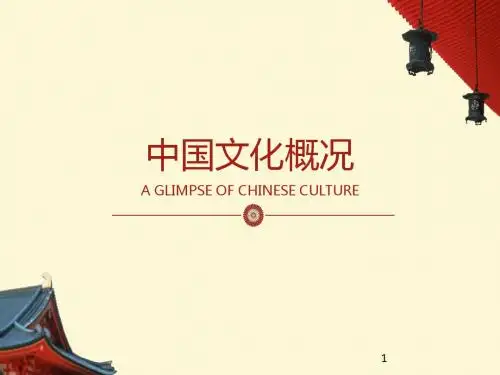
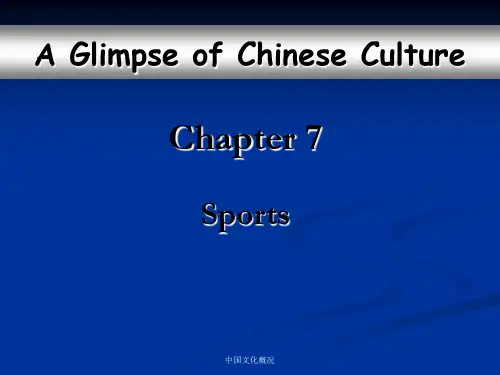
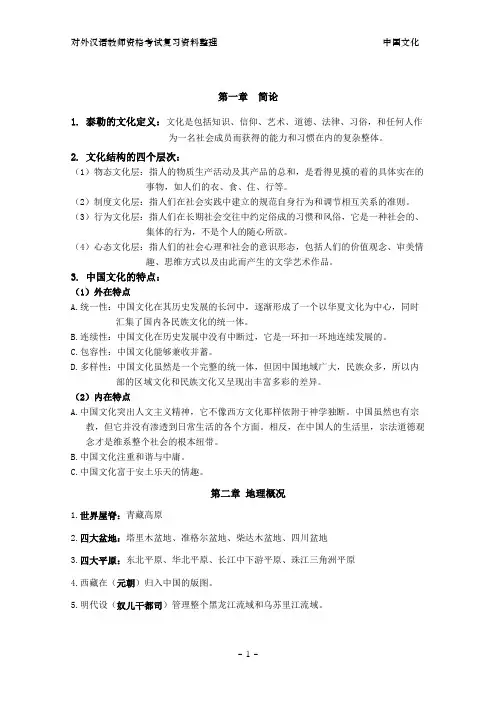
第一章简论1. 泰勒的文化定义:文化是包括知识、信仰、艺术、道德、法律、习俗,和任何人作为一名社会成员而获得的能力和习惯在内的复杂整体。
2. 文化结构的四个层次:(1)物态文化层:指人的物质生产活动及其产品的总和,是看得见摸的着的具体实在的事物,如人们的衣、食、住、行等。
(2)制度文化层:指人们在社会实践中建立的规范自身行为和调节相互关系的准则。
(3)行为文化层:指人们在长期社会交往中约定俗成的习惯和风俗,它是一种社会的、集体的行为,不是个人的随心所欲。
(4)心态文化层:指人们的社会心理和社会的意识形态,包括人们的价值观念、审美情趣、思维方式以及由此而产生的文学艺术作品。
3. 中国文化的特点:(1)外在特点A.统一性:中国文化在其历史发展的长河中,逐渐形成了一个以华夏文化为中心,同时汇集了国内各民族文化的统一体。
B.连续性:中国文化在历史发展中没有中断过,它是一环扣一环地连续发展的。
C.包容性:中国文化能够兼收并蓄。
D.多样性:中国文化虽然是一个完整的统一体,但因中国地域广大,民族众多,所以内部的区域文化和民族文化又呈现出丰富多彩的差异。
(2)内在特点A.中国文化突出人文主义精神,它不像西方文化那样依附于神学独断。
中国虽然也有宗教,但它并没有渗透到日常生活的各个方面。
相反,在中国人的生活里,宗法道德观念才是维系整个社会的根本纽带。
B.中国文化注重和谐与中庸。
C.中国文化富于安土乐天的情趣。
第二章地理概况1.世界屋脊:青藏高原2.四大盆地:塔里木盆地、准格尔盆地、柴达木盆地、四川盆地3.四大平原:东北平原、华北平原、长江中下游平原、珠江三角洲平原4.西藏在(元朝)归入中国的版图。
5.明代设(奴儿干都司)管理整个黑龙江流域和乌苏里江流域。
6.从秦汉到隋代实行(郡县制),从唐宋到辽金实行(道路制),元明清三代实行(行省制)。
7.汉武帝将国分为(十三刺史部(也称十三州)),属于监察性质,还不是行政区域,但却是中国行政区划史上设“州”的开始。
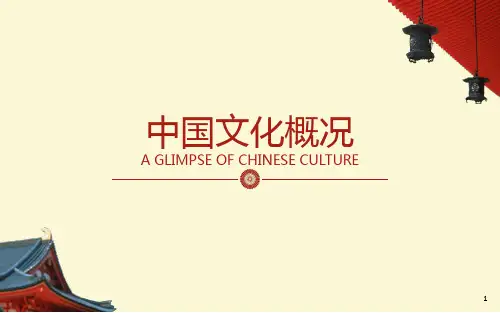
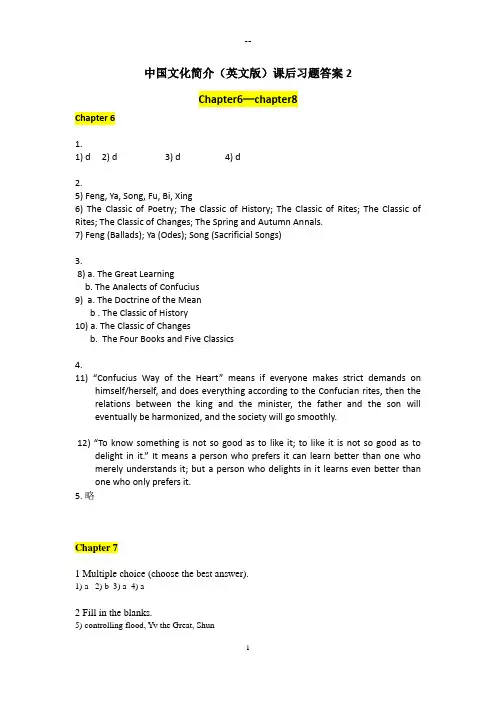
中国文化简介(英文版)课后习题答案2Chapter6—chapter8Chapter 61.1) d 2) d 3) d 4) d2.5) Feng, Ya, Song, Fu, Bi, Xing6) The Classic of Poetry; The Classic of History; The Classic of Rites; The Classic of Rites; The Classic of Changes; The Spring and Autumn Annals.7) Feng (Ballads); Ya (Odes); Song (Sacrificial Songs)3.8) a. The Great Learningb. The Analects of Confucius9) a. The Doctrine of the Meanb . The Classic of History10) a. The Classic of Changesb. The Four Books and Five Classics4.11) “Confucius Way of the Heart”means if everyone makes strict demands onhimself/herself, and does everything according to the Confucian rites, then the relations between the king and the minister, the father and the son will eventually be harmonized, and the society will go smoothly.12) “To know something is not so good as to like it; to like it is not so good as todelight in it.” It means a person who prefers it can learn better than one who merely understands it; but a person who delights in it learns even better than one who only prefers it.5. 略Chapter 71 Multiple choice (choose the best answer).1) a 2) b 3) a 4) a2 Fill in the blanks.5)controlling flood, Yv the Great, Shun6)Pan Gu, Nv Wa, her own model, yellow clay3 Translate the following terms into English7)a. the descendants of Yan and Huang b. Yv the Great controlling the flood8)a. the Eight Immortals crossing the sea. b. Nv Wa creating man9)a. Pan Gu creating the world b.Kua Fu chasing the Sun4 Answer the following questions.10)Huang Di is resourceful in invention as well as in war and is credited with the invention of many things, like carts and boats, clothes, houses, writing and silkworm breeding and Silk weaving. Yan Di is credited with the invention of farming and medicine. He invented the wooden plow and taught people how to treat diseases. Wars urged the mixture and the assimilation of different tribes and eventually formed a tribal alliance of Huang Di and Yan Di. Traditions has it that Chinese civilization originated from the era of Huang Di and Yan Di, for they are the ancestors of the Chinese people. That is why the Chinese call themselves the descendants of Yan and Huang.11)略5 Retell the stories with the help of the following pictures.略Chapter 81.1) a 2)d 3)d 4) a2.5) the guti verse forms, jinti verse forms, classical, verse form, moder6) Shijing7) Li Sao8) Sage Poet, the greatest realist poet9) Su Shi, Li Qingzhao3.10) a. Tang Poems b. Songci11) a. yuanqu b. Chuci4.12) Yuefu originally referred to the “music bureau” in the Han Dynasty, responsible for collecting or writing poems, folk songs and ballads, and having them set to music. Later, poems, folk songs and ballads collected and compiled by yufu were given the name Yuefu.13) Ci is a kind of poetry written to certain tunes with strict tonal patterns and rhyme schemes, in fixed numbers of lines and words, originated in Tang Dynasty and fully developed in Song Dynasty.14) Apart from the above verse forms, there is also Fu, it’s something between poetry and prose, similar to rhapsody: a descriptive poem, and much cultivated from Han times to the Six Dynasties. Examples are Su Shi's “Fu on the Red Cliff”, Ban Gu’s Rhapsody on Two Capitals”, etc.5. 略。
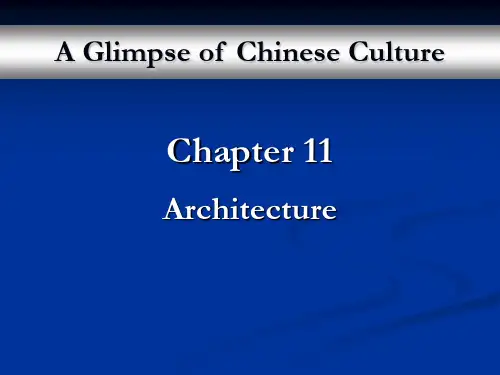
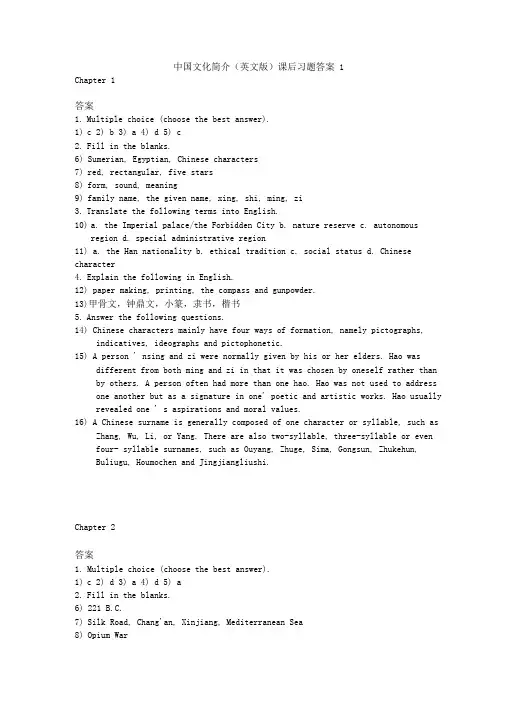
中国文化简介(英文版)课后习题答案 1Chapter 1答案1.Multiple choice (choose the best answer).1)c 2) b 3) a 4) d 5) c2.Fill in the blanks.6)Sumerian, Egyptian, Chinese characters7)red, rectangular, five stars8)form, sound, meaning9)family name, the given name, xing, shi, ming, zi3.Translate the following terms into English.10)a. the Imperial palace/the Forbidden City b. nature reserve c. autonomousregion d. special administrative region11) a. the Han nationality b. ethical tradition c. social status d. Chinese character4.Explain the following in English.12)paper making, printing, the compass and gunpowder.13)甲骨文,钟鼎文,小篆,隶书,楷书5.Answer the following questions.14)Chinese characters mainly have four ways of formation, namely pictographs,indicatives, ideographs and pictophonetic.15) A person ' nsing and zi were normally given by his or her elders. Hao wasdifferent from both ming and zi in that it was chosen by oneself rather than by others. A person often had more than one hao. Hao was not used to address one another but as a signature in one' poetic and artistic works. Hao usually revealed one ' s aspirations and moral values.16) A Chinese surname is generally composed of one character or syllable, such asZhang, Wu, Li, or Yang. There are also two-syllable, three-syllable or even four- syllable surnames, such as Ouyang, Zhuge, Sima, Gongsun, Zhukehun,Buliugu, Houmochen and Jingjiangliushi.Chapter 2答案1.Multiple choice (choose the best answer).1)c 2) d 3) a 4) d 5) a2.Fill in the blanks.6)221 B.C.7)Silk Road, Chang'an, Xinjiang, Mediterranean Sea8)Opium War9)Sun Yat-sen, feudal monarchical system3.Translate the following terms into English.10)a. the Paleolithic Era b. the Neolithic Age c. slave society d. Dream of RedMansions11)a. painted pottery b. the spring and Autumn Period c. socialist market economyd. Opium War4.Explain the following in English.12)During the reign of Emperor Wudi (Liu Che, r. 140-87 B.C.), the Han regimereached the period of its greatest prosperity: The emperor conquered theXiongnu nomads, and sent Zhang Qian as envoy to the Western Regions (Central Asia), and in the process pioneered the route known as the "Silk Road" from the Han capital Chang'an (today's Xi'an, Shaanxi Province), through Xinjiang and onward, finally reaching the east coast of the Mediterranean Sea.13)During the Spring and Autumn and Warring States periods, philosophy and otherbranches of scholarship were unprecedentedly thriving, with therepresentatives of various schools vying with each other in writing books to discuss politics and analyze society. Hence the appearance of a situation in which "a hundred schools of thought contended."5.Answer the following questions.14)The Opium War was the turning point in Chinese history in that it marked theclose of the ancient period and the beginning of the modern history.15)The reason why the construction of the Dujiang Dam was so important inChinese ancient times is that it made possible rationalized irrigationsupply, flood diversion and sand discharge.16)During his reign, Qin Shi Huang standardized the script, currencies, andweights and measures, established the system of prefectures and counties, and constructed the world-renowned Great Wall as well as a large palace,mausoleum and temporary regal lodges respectively in Xianyang, Lishan andother places. In addition, the life-size terracotta horses and armoredwarriors excavated from sites near the mausoleum of Qin Shi Huang are known as the eighth wonder of the world.Chapter 3答案1.Multiple choice (choose the best answer).1.d 2) b 3) a 4) b 5) d2.Fill in the blanks.6)3000, 727)li, yi, yi8)Mo Zi9)Xun Zi, nature, materialism, atheism3.Translate the following terms into English.10)a. Confucianism b. ( Sun Wu’s ) the Art of War c. Confucian analects d. Second Sage11)a. the feudal landlord class b. conservatism c. the policy of benevolence d. the nine-squarefield system4.Explain the following in English.12)The six documents (The Six Classics) under Confucius compilation include Shi (The Book ofSongs), Shu (Collection of Ancient Texts), Li (The Rites), Yue (The Music), Yi (I Ching, or The Classic of Changes), andChun Qiu (The Spring and Autumn Annuals), which are considered as the classics of Confucianism.13)Mencius believed that human beings are good by nature. He held that this goodnessis innateand can be acquired without learning or thinking; one’ s natural goodness is presented by the exercise of benevolence, righteousness, proprieties and prudence. Evil comes into being when one rejects their natural goodness.5.Answer the following questions.14)According to Mencius, the ideal moral personality is that one should never be “ corruptedby neither riches nor honors, shaken by neither peorvty nor adversity, faltered by neither threats nor force ”.15)Han Feizi argued that human nature is basically selfish, and thus the social order can bemaintained only when the ruler imposes rules and his subjects must obey withoutquestioning and enforces them with strict punishments. As a moral and ethical system,“isrtehne ” central theme of Confucius Analects, which focuses on human love that is hierarchical and differentiated. Thus Confucius created his version of humanism. In his idea, human nature is partially good and partially evil. Based on “ ren ” , Confucoibujsected to the fantastic powers that confused the human spirit.16)As one of the greatest thinkers and educators in the history of China, Confucius contributionslie in the following three aspects. Firstly, he compiled and preserved literary works of three generations. The six documents (The Six Classics) under his compilation, including Shi (The Book of Songs), Shu (Collection of Ancient Texts), Li (The Rites), Yue (The Music), Yi(I Ching, or The Classic of Changes), and Chun Qiu (The Spring and Autumn Annuals), areconsidered as the classics of Confucianism. Secondly, Confucius established a system of philosophical thoughts with “ ren ” (benevolenaces)its fundamental virtue. Thirdly, Confucius established private schools and founded a systematic educational framework.Chapter 4答案1.Multiple choice (choose the best answer).1) d 2) d 3) b 4) b 5) c2.Fill in the blanks.6)naturalistic, primitive7)the simplicity, true nature, selfishness, desire8)Old Master9)the social order, individual freedom3.Translate the following terms into English.10)a. prehistoric times b. pessimism c. Taoism d. men-cosmos correspondence11)a. Chinese martial arts b. astrology c. Chinese alchemy d. social order4.Explain the following in English.12)compassion, moderation, and humility13)Mount Longhu (Mount Dragon and Tiger) in Jiangxi Province, Mount Qingcheng in Sichuan Province,Mount Wudang in Hubei Province, and Mount Qiyun in Anhui Province.5.Answer the following questions.14)The core of Lao Zi ' thought is "Tao'(the Way), by which he refered to the condition of theuniverse before the creation of the heaven and the earth. Therefore, it is from Tao that all the elements of the universe are derived. Reversal enables Tao to have a circular movement, that is, when the development of anything brings it to one extreme, a reversal to the other extreme takes place.15)Taoism is one of the most important religions in China, which refers to a variety of relatedphilosophical and religious traditions and concepts. These traditions have influenced East Asia for over two thousand years and some have spread to the West. As the native religion of China, Daoism, together with Confucianism and Buddhism, comprises the main body of traditional Chinese culture. Daoists, in pursuit of the ideal of becoming immortals by practicing Dao, made great efforts to transcend conventional wisdom about life and knowledge and thus helped both to define ancient science in China and to advance it through a great number of inventions. Chinese alchemy, astrology, cuisine, several Chinese martial arts, Chinese traditional medicine, fengshui, and many styles of qigong breath training disciplines have been intertwined with Daoism throughout history.16)Lao Zi ' s “ruling by non-action or inaction reflects the exploration of an intellectual forthe ultimate solution of the social order and individual freedom. His pursuit of vacuity and action through non-action echoes the reality of his time, a period torn by ceaseless wars among states. Lao Zi used the term broadly with simplicity and humility as key virtues, often in contrast to selfish action. On a political level, it means avoiding wars, harsh laws and heavy taxes. For him, it was more important to “see the simplicity, to realize one ' s true nature, to castselfishness, and to temper desireChapter 5答案1.Multiple choice (choose the best answer).1)c 2) c 3) a 4) a 5) d2.Fill in the blanks.6)the Han Dynasty, the Sui and Tang7)Confucianism, Taoism8)Wutai, the “ roof of northern China ”9)Buddhist temples, 76 temples, first3.Translate the following terms into English.10)a. Buddhism b. meditation c. Confucianism d. Buddhist temple11)a. the Great Buddha Hall b. Buddhist scripture c. joss stick d. summer resort4.Explain the following in English.12)The Four Wonders of Mount Emei are the “GolderSummit Sunrise " :' Seof Clouds” ,“Buddha' s Halo " and the “Holy Lamp” .13)The Ten Schools of Chinese Buddhism are as follows:a.Reality School or Kosa School or Abhidharma School.b.Satysiddhi School or Cheng-se School.c.Three Sastra School or San-lun School.d.The Lotus School or T'ien-t'ai School.e.The Garland School or Hua-yen.f.Intuitive School or Ch'an School or Dhyana School.g.Discipline School or Lu School or Vinaya School.h.Esoteric School or Chen-yien School or Mantra School.i.Dharmalaksana School or Ch'u-en School or Fa-siang School.j.Pure-land School or Sukhavati School or Ching-t'u School.5.Answer the following questions.14)The cornerstone of Buddhist philosophy is the view that all life is suffering.15)the doctrine of Four Noble Truths refers to: life is suffering, the cause of suffering isdesire, the answer is to quench desire, and the way to this end is to follow the Eight-Fold Path, which consists of right knowledge, right thought, right speech, right behavior, right livelihood, right effort, right mindfulness and right concentration.16)When Li Bai, famous Chinese poet of the Tang Dynasty, was invited to Mount Jiuhua, he wasoverwhelmed by the scene of nine peaks that look like lotus blooms from heaven. Out of admiration he composed the lines: "Twcforces preserve between the World and the Heaven; Nine lotuses blossom on the Jiuhua Mountain. "Since then the mountain has been attracting men of letters throughout the ages, and thus Jiuhua obtained its fame.第二章中国文史小常识1、谥号是古代对死去的人按其生平事迹评定后,给予褒贬或屿的称号,谥号可与庙号结合,或为全称的组成部分,也可独立使用。


《中国文化概论》课后习题答案中国文化概论(修订版)张岱年第一章中国文化的历史地理环境 (2)第二章中国文化植根的经济基础(2)第三章中国文化依赖的社会政治结构(3)第四章中国传统文化的发展历程 (3)第五章中国的多民族文化融合与中外文化交汇(5)第六章中国语言文字(5)第七章中国古代科学技术 (6)第八章中国古代教育(7)第九章中国古代文学 (7)第十章中国古代艺术(8)第十一章中国古代史学(8)第十二章中国传统伦理道德(8)第十三章中国古代宗教 (10)第十四章中国古代哲学(11)第十五章中国文化的类型与特点 (11)第十六章中国文化的基本精神 (12)第十七章中国传统文化的价值系统 (13)第十八章中国传统文化向近代的转变(15)第十九章建设社会主义的中国新文化(15)绪论一为什么说文化就就是“自然的人化”?文化的实质性含义就是指:人化或人类化,即人类主体通过社会实践活动,适应、利用、改造自然界客体而逐步实现自身价值观念的过程。
其体现即有自然面貌、形态、功能的不断改观;也有人类个体与群体素质的不断提高与完善。
二怎样理解广义文化与狭义文化的联系与区别?广义的文化,着眼于人类与一般动物,人类社会与自然界的本质区别,着眼于人类卓立于自然的独特的生存方式,其涵盖面非常广泛,所以又被称为大文化。
狭义的文化排除人类社会——历史生活中关于物质创造活动及其结果的部分,专注于精神创造活动及其结果,主要就是心态文化,又称“小文化”。
书本绪论为什么说文化就就是“自然的人化”三文化结构的四层次包括哪些内容?对文化的结构解剖,有两分说,即分为物质文化与精神文化;有三层次说,即分为物质、制度、精神三层次;有四层次说,即分为物质、制度、风俗习惯、思想与价值。
有六大子系统说,即物质、社会关系、精神、艺术、语言符号、风俗习惯等。
(注意:这里还就是记住为好,六大系统可简记为:社语俗物精艺)四怎样认识与评价中国传统文化?中国传统文化就是中华民族历史的结晶,具有历史性与现实性,不就是博物馆里的陈列品,传统文化所蕴含的、代代相传的思维方式、价值观念、行为准则、一方面具有强烈的历史性、遗传性;另一方面具有鲜活的现实性、变异性,它无时无刻不在影响着今天的中国人,为我们开创新文化提供历史的根据与现实的基础。
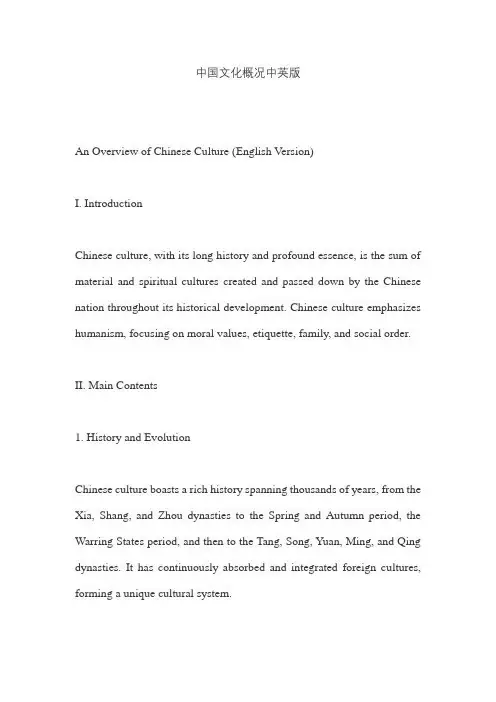
中国文化概况中英版An Overview of Chinese Culture (English Version)I. IntroductionChinese culture, with its long history and profound essence, is the sum of material and spiritual cultures created and passed down by the Chinese nation throughout its historical development. Chinese culture emphasizes humanism, focusing on moral values, etiquette, family, and social order.II. Main Contents1. History and EvolutionChinese culture boasts a rich history spanning thousands of years, from the Xia, Shang, and Zhou dynasties to the Spring and Autumn period, the Warring States period, and then to the Tang, Song, Yuan, Ming, and Qing dynasties. It has continuously absorbed and integrated foreign cultures, forming a unique cultural system.2. Traditional ValuesConfucianism is one of the cornerstones of Chinese culture, emphasizing virtues such as benevolence, filial piety, loyalty, and etiquette, which have profoundly influenced the behavior and values of the Chinese people. Taoism emphasizes the harmony between man and nature, advocating a natural and non-interventionist approach. Buddhism, on the other hand, emphasizes compassion and self-sacrifice, having a significant impact on Chinese religion and philosophy.3. Cultural Characteristics- Festival Culture: China has many traditional festivals, such as the Spring Festival, Mid-Autumn Festival, and Dragon Boat Festival, each with unique celebration methods and cultural connotations.- Clothing Culture: Traditional Chinese clothing, such as Hanfu and Tangzhuang, reflects the unique aesthetic concepts and cultural characteristics of the Chinese nation.- Architectural Culture: Traditional Chinese architecture, including palaces, temples, and gardens, is renowned for its distinctive styles and exquisite craftsmanship.- Cuisine Culture: Chinese cuisine, known for its rich flavors and exquisiteculinary techniques, is an important representation of China's cultural charm.4. Influence on the WorldThe values and ideological systems of Chinese culture have had a profound impact on the world, especially Confucianism, which has influenced Asia and beyond. Traditional Chinese arts and forms of expression, such as calligraphy, painting, and Peking Opera, are also deeply loved and admired by people around the world.III. ConclusionChinese culture is a treasure of the Chinese nation, embodying unique charm and value. Through learning and understanding Chinese culture, we can gain a deeper understanding of the history, traditions, and spiritual outlook of the Chinese people, further enhancing our sense of national pride and self-confidence. At the same time, Chinese culture has also made significant contributions to the diversity and development of world culture.中国文化概况中英版一、引言中国文化,源远流长,博大精深,是中华民族在长期历史发展过程中所创造并传承下来的物质文化和精神文化的总和。
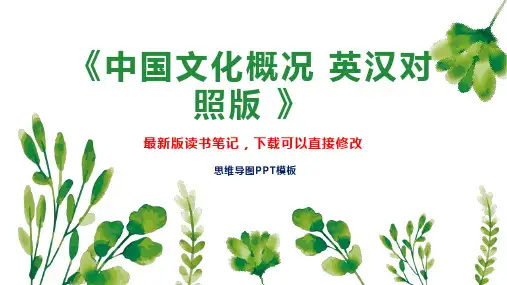
中国文化简介(英文版)课后习题答案1Chapter 1答案1. Multiple choice (choose the best answer).1) c 2) b 3) a 4) d 5) c2. Fill in the blanks.6) Sumerian, Egyptian, Chinese characters7) red, rectangular, five stars8) form, sound, meaning9) family name, the given name, xing, shi, ming, zi3. Translate the following terms into English.10) a. the Imperial palace/the Forbidden City b. nature reserve c.autonomous region d. special administrative region11) a. the Han nationality b. ethical tradition c. social status d. Chinese character4. Explain the following in English.12) paper making, printing, the compass and gunpowder.13) 甲骨文,钟鼎文,小篆,隶书,楷书5. Answer the following questions.14) Chinese characters mainly have four ways of formation, namelypictographs, indicatives, ideographs and pictophonetic.15) A person’s ming and zi were normally given by his or her elders.Hao was different from both ming and zi in that it was chosen by oneself rather than by others. A person often had more than one hao. Hao was not used to address one another but as a signature in one’s poetic and artistic works. Hao usually revealed one’s aspirations and moral values.16) A Chinese surname is generally composed of one character orsyllable, such as Zhang, Wu, Li, or Yang. There are also two-syllable, three-syllable or even four-syllable surnames, such as Ouyang, Zhuge, Sima, Gongsun, Zhukehun, Buliugu, Houmochen and Jingjiangliushi.Chapter 2答案1.Multiple choice (choose the best answer).1) c 2) d 3) a 4) d 5) a2. Fill in the blanks.6) 221 B.C.7) Silk Road, Chang'an, Xinjiang, Mediterranean Sea8) Opium War9) Sun Yat-sen, feudal monarchical system3. Translate the following terms into English.10) a. the Paleolithic Era b. the Neolithic Age c. slave society d.Dream of Red Mansions11) a. painted pottery b. the spring and Autumn Period c. socialist market economyd. Opium War4. Explain the following in English.12) During the reign of Emperor Wudi (Liu Che, r. 140-87 B.C.), theHan regime reached the period of its greatest prosperity: The emperor conquered the Xiongnu nomads, and sent Zhang Qian as envoy to the Western Regions (Central Asia), and in the process pioneered the route known as the "Silk Road" from the Han capital Chang'an (today's Xi'an, Shaanxi Province), through Xinjiang and onward, finally reaching the east coast of the Mediterranean Sea.13) During the Spring and Autumn and Warring States periods,philosophy and other branches of scholarship were unprecedentedly thriving, with the representatives of various schools vying with each other in writing books to discuss politics and analyze society. Hence the appearance of a situation in which "a hundred schools of thought contended."5. Answer the following questions.14) The Opium War was the turning point in Chinese history in that itmarked the close of the ancient period and the beginning of the modern history.15) The reason why the construction of the Dujiang Dam was soimportant in Chinese ancient times is that it made possible rationalized irrigation supply, flood diversion and sand discharge.16) During his reign, Qin Shi Huang standardized the script,currencies, and weights and measures, established the system of prefectures and counties, and constructed the world-renowned Great Wall as well as a large palace, mausoleum and temporary regal lodges respectively in Xianyang, Lishan and other places.In addition, the life-size terracotta horses and armored warriors excavated from sites near the mausoleum of Qin Shi Huang are known as the eighth wonder of the world.Chapter 3答案1.Multiple choice (choose the best answer).1) d 2) b 3) a 4) b 5) d2. Fill in the blanks.6) 3000, 727) li, yi, yi8) Mo Zi9) Xun Zi, nature, materialism, atheism3. Translate the following terms into English.10) a. Confucianism b. (Sun Wu’s) the Art of War c. Confuciananalects d. Second Sage11) a. the feudal landlord class b. conservatism c. the policy ofbenevolence d. the nine-square field system4. Explain the following in English.12) The six documents (The Six Classics) under Confucius compilationinclude Shi (The Book of Songs), Shu(Collection of Ancient Texts), Li(The Rites), Yue(The Music), Yi (I Ching, or The Classic of Changes), and Chun Qiu (The Spring and Autumn Annuals), which are considered as the classics of Confucianism.13) Mencius believed that human beings are good by nature. He heldthat this goodness is innate and can be acquired without learning or thinking; one’s natural goodness is presented by the exercise of benevolence, righteousness, proprieties and prudence. Evil comes into being when one rejects their natural goodness.5. Answer the following questions.14) According to Mencius, the ideal moral personality is that oneshould never be “corrupted by neither riches nor honors, shaken by neither poverty nor adversity, faltered by neither threats nor force”.15) Han Feizi argued that human nature is basically selfish, and thusthe social order can be maintained only when the ruler imposes rules and his subjects must obey without questioning and enforces them with strict punishments. As a moral and ethical system, “ren” is the central theme of Confucius Analects, which focuses on human love that is hierarchical and differentiated. Thus Confucius created his version of humanism. In his idea, human nature is partially good and partially evil. Based on “ren”, Confucius objected to the fantastic powers that confused the human spirit.16) As one of the greatest thinkers and educators in the history ofChina, Confucius’ contributions lie in the following three aspects. Firstly, he compiled and preserved literary works of three generations. The six documents (The Six Classics) under hiscompilation, including Shi (The Book of Songs), Shu (Collection of Ancient Texts), Li (The Rites), Yue (The Music), Yi (I Ching, or The Classic of Changes), and Chun Qiu (The Spring and Autumn Annuals), are considered as the classics of Confucianism. Secondly, Confucius established a system of philosophical thoughts with “ren”(benevolence) as its fundamental virtue.Thirdly, Confucius established private schools and founded a systematic educational framework.Chapter 4答案1.Multiple choice (choose the best answer).1) d 2) d 3) b 4) b 5) c2. Fill in the blanks.6) naturalistic, primitive7) the simplicity, true nature, selfishness, desire8) Old Master9) the social order, individual freedom3. Translate the following terms into English.10) a. prehistoric times b. pessimism c. Taoism d. men-cosmoscorrespondence11) a. Chinese martial arts b. astrology c. Chinese alchemy d. social order4. Explain the following in English.12) compassion, moderation, and humility13) Mount Longhu (Mount Dragon and Tiger) in Jiangxi Province, MountQingcheng in Sichuan Province, Mount Wudang in Hubei Province, and Mount Qiyun in Anhui Province.5. Answer the following questions.14) The core of Lao Zi’s thought is “Tao” (the Way), by which herefered to the condition of the universe before the creation of the heaven and the earth. Therefore, it is from Tao that all the elements of the universe are derived. Reversal enables Tao to have a circular movement, that is, when the development of anything brings it to one extreme, a reversal to the other extreme takes place.15) Taoism is one of the most important religions in China, whichrefers to a variety of related philosophical and religious traditions and concepts. These traditions have influenced East Asia for over two thousand years and some have spread to the West.As the native religion of China, Daoism, together with Confucianism and Buddhism, comprises the main body of traditional Chinese culture. Daoists, in pursuit of the ideal of becoming immortals by practicing Dao, made great efforts to transcend conventional wisdom about life and knowledge and thus helped both to define ancient science in China and to advance it through a great number of inventions. Chinese alchemy, astrology, cuisine, several Chinese martial arts, Chinese traditional medicine, fengshui, and many styles of qigong breath training disciplines have been intertwined with Daoism throughout history.16) Lao Zi’s “ruling by non-action or inaction” reflects theexploration of an intellectual for the ultimate solution of the social order and individual freedom. His pursuit of vacuity and action through non-action echoes the reality of his time, a period torn by ceaseless wars among states. Lao Zi used the term broadly with simplicity and humility as key virtues, often in contrast to selfish action. On a political level, it means avoiding wars, harsh laws and heavy taxes. For him, it was more important to “see the simplicity, to realize one’s true nature, to cast off selfishness, and to temper desire”.Chapter 5答案1. Multiple choice (choose the best answer).1) c 2) c 3) a 4) a 5) d2. Fill in the blanks.6) the Han Dynasty, the Sui and Tang7) Confucianism, Taoism8) Wutai, the “roof of northern China”9) Buddhist temples, 76 temples, first3. Translate the following terms into English.10) a. Buddhism b. meditation c. Confucianism d. Buddhist temple11) a. the Great Buddha Hall b. Buddhist scripture c. joss stick d. summer resort4. Explain the following in English.12) The Four Wonders of Mount Emei are the “Golden Summit Sunrise”, “Sea of Clouds”, “Buddha’s Halo” and the “Holy Lamp”.13) The Ten Schools of Chinese Buddhism are as follows:a. Reality School or Kosa School or Abhidharma School.b. Satysiddhi School or Cheng-se School.c. Three Sastra School or San-lun School.d. The Lotus School or T'ien-t'ai School.e. The Garland School or Hua-yen.f. Intuitive School or Ch'an School or Dhyana School.g. Discipline School or Lu School or Vinaya School.h. Esoteric School or Chen-yien School or Mantra School.i. Dharmalaksana School or Ch'u-en School or Fa-siang School.j. Pure-land School or Sukhavati School or Ching-t'u School.5. Answer the following questions.14) The cornerstone of Buddhist philosophy is the view that all lifeis suffering.15) the doctrine of Four Noble Truths refers to: life is suffering,the cause of suffering is desire, the answer is to quench desire, and the way to this end is to follow the Eight-Fold Path, which consists of right knowledge, right thought, right speech, right behavior, right livelihood, right effort, right mindfulness and right concentration.16) When Li Bai, famous Chinese poet of the Tang Dynasty, was invitedto Mount Jiuhua, he was overwhelmed by the scene of nine peaks that look like lotus blooms from heaven. Out of admiration he composed the lines: “Two forces preserve between the World and the Heaven; Nine lotuses bloss om on the Jiuhua Mountain.” Since then the mountain has been attracting men of letters throughout the ages, and thus Jiuhua obtained its fame.(注:文档可能无法思考全面,请浏览后下载,供参考。
形容词重叠
A——AA
高——高高(很高)高高的个子——他的个子高高的红——红红(很红)红红的苹果——苹果红红的,很甜大——
满——
长——
AB——AABB
干净——干干净净(很干净)干干净净的公寓——
这间公寓干干净净的,我很满意清楚——清清楚楚(很清楚)清清楚楚地写着——
黑板上清清楚楚地写着四个大字:…. 漂亮——漂漂亮亮
????
美丽——美美丽丽×
可爱——可可爱爱×
再说
再说,咱们家的水果还没吃完呢。
A:你为什么不买?
B:这件衣服对我不合适,再说我也没那么多钱。
(原因1)(原因2)
原因1比原因2重要
A:你为什么常常去旅行?
B:旅行可以认识很多新朋友,也可以练习汉语,再说,还可以吃到很多地方的好东西。
A:你为什么学习汉语?
B:…….
A :这个周末我们出去玩儿吧。
B:……
V 1 再 V2
我们先听写,然后再上课。
——听写完了再上课。
我们去吃饭,然后回宿舍。
——吃完饭了再回宿舍。
我们先去曼谷,然后回普吉。
——去了曼谷再回普吉。
吃药睡觉——吃了药再睡觉——你应该吃了药在睡觉。
写作业玩儿——
爸爸回来吃饭——
上课逛街——。
Chapter 1 A General Introduction to Chinese CultureWords and Expressions:the descendants of Yan and Huang 炎黄子孙porcelain 瓷器The appellation of ChinaChinese history began with two legendary figures—Emperor Huang and Emperor Yan, who, together with their tribes, inhabited the drainage area along the middle reaches(中游)of the Yellow River. By the time of Xia Dynasty, after centuries of living side by side, these two tribes had gradually merged into(合并,融合)one. Consequently, the Chinese people usually call themselves “the descendants of Yan and Huang”.People at that time believed that the land they lived on was the center of the world, and called their state the "Middle Kingdom"(中国), thus giving China its country name.China is the appellation of our country given by foreigners. The porcelain china is the transliteration of the place name Changnan(昌南), which was the old name for Jingdezhen(景德镇). The porcelain made in Changnan was smooth and bright, and earned another name of artificial jade. It became famous both home and abroad and was exported to Europe in large quantities.In Europe, people regarded Changnan porcelain as something precious and delicate and would take pride in possessing one. As time passed, people in Europe forgot the meaning of Changnan and switched the original meaning of porcelain of the word “china” to the place of its origin.Chapter 2 Chinese Philosophy and ReligionPart 1 Chinese Thoughts and PhilosophyWords and Expressions:Confucianism 儒家Taoism 道家The Analects 《论语》benevolence 仁慈,善行ritual礼制,仪式,惯例filial piety 孝,孝心The Development of Ancient Chinese PhilosophyThe philosophy in Pre-Qin times (先秦子学)The orthodox philosophy during the Han Dynasty (两汉经学)Metaphysics during the Wei and Jin dynasties (魏晋玄学)The buddhist philosophy during the Sui and Tang dynasties (隋唐佛学)Neo-confucianism in Song and Ming dynasties (宋明理学)Application philosophy in the Ming and Qing dynasties (明清实学)The philosophy in Pre-Qin times (先秦子学)The philosophy in Pre-Qin times was marked by the emergence of various ancient philosophical views.The most influential schools were Confucianism (儒家), Taoism (道家), Mohism (墨家) and Legalism (法家)1.ConfucianismConfucianism is a school of thought represented by Confucius and Mencius. Confucianism has influenced the Chinese for thousands of years and is deeply rooted in Chinese culture. It is an integration of intellectual, political, and religious tradition with the focus on the individual morality and ethics in daily life and the proper exercise of political power.Who is Confucius?Family name: Kong; Given name: Qiu; courtesy name: ZhongniHe is a great thinker, an educator, a statesman, a philosopher, the founder of the Confucian school and Confucianism.The landmark of Confucianism is the Analects, which was written by his disciples after his death. The core of Confucius’s philosophy are the concepts ofRen (benevolence)Ren(仁): Confucius defines it as “Airen”(爱人),that is , to love others.The Chinese character “仁”(benevolence) consists of “a person (人)” on the left and “two(二)” on the right indicating the relationship between people.Li (ritual)Li (ritual-礼)refers to the rules of human conduct and moral norms such as politeness, courtesy, propriety, proper etiquette and good manners ranging from speech and behavior to the performance of rituals which are usually codified and treated as an all-embracing system of socialnorms.Xiao (filial piety)Xiao(孝)refers to the filial piety, which was regarded as one of the greatest of virtues in Chinese tradition, denoting the respect and obedience that the children should show to their parents. Zhong (loyalty)Zhong(loyalty-忠)is a great virtue, which emphasizes the obligations and duties to the superior, to friends, family, and spouse.2. TaoismFounded by Lao Zi and Zhuang Zi, the school advocates the doctrine that the Dao is the course, the principle, the substance, and the standard of all things, to which all of them must conform. Based on the work of Dao De Jing, Taoism promotes the belief that a person should live a simple life, not to strive for wealth, fame or power, which will only give one worries and trouble. The school favours the political principle of “achieving good government through non-action”(无为而治)3. MohismBase on the teaching of Mozi, the school cherishes universal love which states that if all the people in the world loved one another, there will be no hatred, calamities, and hostilities.In politics and ethics, Mohism proposes honoring virtuous people, opposing fatalism (宿命论) and aggressive wars, and upholding thriftiness(节俭).4. LegalismLegalism, begun by Hanfeizi, espouses (主张) laying down laws to unify the thought of people, promoting agriculture to achieve affluence (富裕), waging (进行) wars to gain strength and power, and establishing a system of bureaucracy (官僚制度).The orthodox philosophy during the Han Dynasty (两汉经学)In the Han Dynasty, Emperor Wudi instituted the campaign of “banning all schools of thought except Confucianism(罢黜百家,独尊儒术)”. He chose officials from th ose who were steeped in Confucianism only. Consequently, Confucianism became an orthodox school that served as the ideological foundation of the feudal rule throughout the dynasties in China.Traditional Chinese ethicsTraditional Chinese ethics includes both good and bad elements. Some reflect the high standard ofmoral pursuit of the Chinese people, while others seem less relevant in modern society. For example, the three obediences and four virtues (三从四德) and the three basic rules and five constant virtues (三纲五常) have long been abandoned by the Chinese people.The traditional ideal of a woman is that she is a dependant being whose behavior is governed by “three obediences” (to father before marriage, to husband after marriage, and to son after becoming a widow: 未嫁从父, 既嫁从夫, 夫死从子) and four “virtues” (morality, pro per speech, modest manner, and diligence: 品德、言语、仪态、女工).These were the social norms prescribed by feudal morality.The three basic rules: a king should rule over his subjects; a father, his son; a husband, his wife (君为臣纲、父为子纲、夫为妻纲).The five constant virtues: benevolence, righteousness, propriety, wisdom, and fidelity (仁、义、礼、智、信).Part 2 Religions and BeliefsWords and Expressions:Heaven worship 祭天Ancestor worship 祭祖Confucianism 儒教The Confucian Temple 孔庙Taoism 道教The Five Elements 五行Buddhism 佛教Buddha 佛像,佛祖,佛陀nirvana涅盘Heaven worshipThe heaven worship was the bureaucratic(官僚的) belief system adopted by most dynasties of China until the overthrow(推翻) of the Qing Dynasty.Heaven was believed to manifest itself through the powers of the weather and natural disasters. Heaven was seen as a judge of humans.The emperors are Sons of Heaven(天子), and their power are authorized by heaven. Such beliefs actually consolidated(巩固) the authority of the Emperor.Ancestor worshipChinese worship of ancestors dates back to the prehistory. Chinese culture, Confucianism, and Chinese Buddhism all value filial piety as a top virtue, and the act is a continued display of piety and respect towards departed ancestors.Confucianism儒教Confucianism is not a real religion, it is just an ethical(伦理道德的) and philosophical system, which developed from?Confucius’ thoughts and later was treated as a kind of belief to educate common people(教化大众).The Taoist ReligionA General Introduction of TaoismTaoism is the indigenous (土生土长的) religion in China.The Taoist religion evolved out of witchcraft (巫术), necromancy(方术) and self-cultivation techniques. Its highest belief is called “Dao”, its bible is called “Dao De Jing”. It had great impact on the thinking of the Chinese people, as well as on the political, economic and cultural life of the country.BeliefsYin-yang TheoryYin-yang are opposing, Yin-yang are mutually rooted, Yin-yang mutually transform, Yin-yang mutually wax and waneThe Five Elements/Wuxing“五行”The relationship between the five elements:The Generating CycleWood feeds Fire; Fire creates Earth; Earth bears Metal; Metal carries Water; Water nourishes Wood.The Overcoming CycleWood parts Earth; Earth absorbs Water; Water quenches Fire; Fire melts Metal; Metal chops Wood.BuddhismBuddhism is the most important religion in China. It is generally believed that it was spread to China in 67 AD during the Han Dynasty (206 BC-220) from Hotan(和田)in Xinjiang to Central China. During its development in China, it has a profound (深远的)influence on traditionalChinese culture and thoughts, and has become one of the most important religions in China at that time.Its Deity is Sakyamuni(释迦牟尼);Its doctrine is based on transmigration(轮回).What is the fundamental cause of all suffering?Desire!What did the Buddha teach?The doctrine of Four Noble Truths (四谛)⏹life is suffering,⏹the cause of suffering is desire,⏹the answer is to quench (抑制) desire,⏹the way to this end is to follow the Eight-Fold Path (八正道).What do Buddhists believe?Nirvana is a peaceful, detached state of mind.Achieving Nirvana means escape from the cycle of rebirth.Buddhism in China has developed into three sections, namely the Han, Tibetan and Southern Buddhism.Chapter 3 Chinese Characters, Calligraphy and PaintingWords and Expressions:Chinese Characters 汉字calligraphy书法calligrapher书法家Oracle bone script甲骨文The regular Script 楷书Four Treasures of the Study 文房四宝brush 毛笔ink stick 墨ink stone 砚台The origin of the Chinese characters1.Keep records by tying knots (结绳说)2.The Eight Diagrams (八卦说)3.Cang Jie created the characters(仓颉造字说)The evolution of Chinese characters font(汉字的字体演变)Oracle bone scriptIt refers to incised(雕刻的) ancient Chinese characters found on oracle bones, which are animal bones or turtle shells used in divination(预言) in ancient China.Bronze ware script金文It refers to characters found engraved on bronze vessels, utensils, weapons etc.The Seal Characters (篆书)Soft lines of strokes and upright rectangular shape keep the seal form characters more close to pictography (象形文字). Each of the characters has a balanced and symmetrical (对称的) pattern. The Official Script(隶书)It was the turning point in the evolution of Chinese scripts and is the foundation of the later script forms. It turned the remaining curved and round strokes of the seal form into linear (直线的) and flat square (扁方形) shapes.The regular Script (楷书)It is still today’s standard writ ing. It is square in form, and non-cursive in strokes.The running Script (行书)The running form is somewhere between the regular and the cursive forms allowing simpler and faster writing.The Cursive/Grass Character(草书)This style of calligraphy is smooth and lively with strokes flowing and characters linking together.The characters are often joined, with the last stroke of one merging into the initial stroke of the next. It is executed freely and rapidly so that parts of the characters appear exaggerated (夸张的).CalligraphyPlaying musical instruments, playing chess, calligraphy and painting were considered as the four essential skills for a learned scholar.The Chinese saying “The handwriting reveals the person” (字如其人), is directly related to calligraphy.Four Treasures of the Study 文房四宝brush毛笔ink stick墨paper 纸ink stone砚Famous Chinese Calligraphers in HistoryWang Xizhi —the sage of Chinese calligraphyZhang Xu (张旭)——the “sage of the cursive hand””草圣”Yan Zhenqing——the four greatest masters of Regular script.Liu Gongquan——a master of Regular Script and Running-cursive(行草)PaintingPaintingChinese Traditional Painting refers to ink - wash painting (水墨画) .Traditional Chinese paintings are not “purely” paintings. T hey combine fine art, poetry, calligraphy, and seal engraving to achieve an artistic unison (一致). Human figures, landscapes, flowers, birds, and pavilions are the most important themes of traditional Chinese painting.The classification of Chinese paintingAccording to subject matterFigure paintingLandscape paintingBird-and-flower paintingAccording to the techniqueThe xie yi schoolThe gong bi schoolChapter 4 LiteratureWords and ExpressionsCelestial Poet (诗仙)Saint Poet (诗圣)Romance of the Three Kingdoms 《三国演义》Water Margin《水浒传》Journey to the West《西游记》Dream of the Red Mansions《红楼梦》The Tang PoemThe Tang Dynasty saw the continued development of Chinese poetry. The Complete Anthology of Tang Poems (《全唐诗》), edited in the early Qing Dynasty, is the biggest-ever collection of Chinese poetry. It contains 48,977 poems by 2,208 poets who wrote in different styles.The development of poetry in the Tang Dynasty can be classified into four stages, namely Early Tang, High Tang, Mid Tang, and Late Tang (初唐,盛唐,中唐,晚唐)Early TangThe Four Literary Eminences(初唐四杰)Wang Bo, Yang Jiong, Luo Binwang, and Lu ZhaolinHigh TangA whole generation of literary giants appeared during the High Tang period when society enjoyed prosperity and stability. Li Bai and Du Fu are regarded as the twin master poets of the Tang Dynasty.Li Bai,the “Celestial Poet (诗仙)”, has long been regarded the greatest romantic poet in Chinese literature. In his poems, imagination, exaggeration, diction and sonorous rhythms are blended effortlessly.Du Fu, the “Saint Poet (诗圣)”, has been considered as the greatest realistic poet in Chinese literature. A mirror of the times, his poems faithfully and profoundly reflect the social realities of Tang Dynasty in decline, like a poetic historical account. Because he reached perfection in developing a depressing literary style, his works have been considered as the classics of realism. The other poets in this period can be grouped into two categories: frontier poets (边塞诗人)represented by Gao Shi and Cen Shen, and pastoral poets (田园诗人)represented by Meng Haoran and Wang Wei.Mid-TangThe outstanding poet Bai Juyi succeeded Du Fu with poems reflecting the reality of society.Late TangWith the deterioration of the government in the late Tang Dynasty, the poems reflected, more and more, the hopeless and helpless feelings of the people. Poets turned to the theme of nostalgia (怀旧) for the former splendor (辉煌)of old times. The most talented of these were Li Shangyin and Du Mu, who were often called “Young Li Bai and Du Fu”.Fiction in the Ming and Qing DynastyIn the Song Dynasty, huaben (话本), the earliest novels written in colloquial language started to appear. By the Ming and Qing dynasties, novels grew rapidly as a lively and free literary form. The language of the novels was simple, easy to understand, and welcomed by the public.Four famous Chinese classical novelsRomance of the Three Kingdoms 《三国演义》Water Margin《水浒传》Journey to the West《西游记》Dream of the Red Mansions《红楼梦》Winner of the Noble Prize in Literature, Mo YanOn 11 October 2012, the Swedish Academy announced that Mo Yan had received the Nobel Prize in Literature for his work . Aged 57 at the time of the announcement, he was the 109th recipient of the award and the first ever resident of mainland China to receive it .Mo Yan has written 11 novels, and several novellas and short story collections.《红高粱家族》Red Sorghum, 《天堂蒜薹之歌》The Garlic Ballads, 《十三步》Thirteen Step,《食草家族》The Herbivorous Family, 《丰乳肥臀》Big Breasts and Wide Hips, 《酒国》The Republic of Wine: A Novel,《红树林》Red Forest, 《檀香刑》Sandalwood Death, 《生死疲劳》Life and Death Are Wearing Me Out, 《四十一炮》Pow!, 《蛙》FrogChapter 5 EducationWords and ExpressionsPrivate Schools私塾Official Schools官学the Four Books and the Five Classics四书五经Imperial Examination 科举Nine-year Compulsory Education 九年制义务教育V ocational Education 职业教育College Entrance Examination 高考Bachelor’s degree学士学位Master’s degree 硕士学位Doctor’s degree 博士学位Confucius Institute孔子学院Private SchoolsA private school refers to a school set up by a family, clan, or teacher that generally had just one teacher who gave individual tuition, and that had no set textbooks and no specified time span of study.In the Spring and Autumn Period, private schools prevailed and many scholars of different schoolsof thought spread their teaching in this way. Among them, the private school run by Confucius was the largest and most influential.Confucius’ private school:3000ciples(弟子); 72 virtuous and talented studentsConfucius’ educational ideas:“Education should be for all, irrespective of their social status.”(有教无类)“Six arts”: ritual, music, archery, chariot-riding, writing, and arithmetic.(六艺:礼、乐、射、御、书、数)Official SchoolsOfficial schools began during the Western Zhou Dynasty, and were sponsored by the official constitution called Xiangxue .Only children of nobles were admitted.The teaching materials were centered on the Four Books and the Five Classics(四书五经). Imperial Examination System (科举)Imperial Examination System in China began in the Sui Dynasty and lasted more than 1,300 years until the last examination was held during the Qing Dynasty.It was conducted at two levels: xiangshi(乡试) and huishi(会试)During the Ming and Qing Dynasty, the examination was designed to select jinshi(进士). It featured writing ,which involved the writing of an Eight-part Essay(八股文).After the Opium War in 1840 with the spread of the Western ideology and technology in China , it was under attack by people. It was abolished in 1905.Nine-year Compulsory EducationThe law of compulsory education came into effect on July 1, 1986, requiring each child to have nine years of formal education.China’s Nine-year Compulsory Education is composed of two parts: six-years in primary school and three-years in junior high school.In 1989, China launched two ambitious projects: Project Hope (希望工程) and the Spring Bud Project (春蕾计划) These two projects have helped children, especially girls, in poor areas to attend schools.The National College Entrance Examination is an academic examination held annually in China aimed to select high-school graduates for college admissions.Higher EducationMore than two thousand universities, colleges, and institutes in China offer four or five-year programs. Students who have earned Bachelor of Arts or Science degrees may apply for Master of Arts or Science programs and then three-year Doctor of Philosophy (Ph.D.) programs. Confucius InstituteConfucius Institute is not a general sense of the university, but the promotion and dissemination (传播)of Chinese culture and Chinese language education.Chapter 6 Dress and Adornment CultureWords and Expressionsattire/ costume/trappings 服装、服饰The Silk Road 丝绸之路The Maritime Silk Road海上丝绸之路embroidery/im‘br?id?ri /刺绣;刺绣品Li Brocade 黎锦The Intangible Cultural Heritage 非物质文化遗产China has many ethnic groups with a long history. For thousands of years, generations of clothing designers have devoted themselves to building the Kingdom of Clothes, making the garments that cover the human body into an important component of Chinese culture.Cheong-sam(Qi Pao)Cheong-sam came from Qizhuang of manchu women’s costume. The cheongsam is easy and comfortable to wear, snugly fitting the female Chinese figure. Its neckline is high, collar closed, and its sleeves may be short, med ium or full length, depending on the season or the wearer’s taste. The dress is buttoned on the right side, with a loose bodice, a fitted waist, and side-slits to the hem, all of which combine to set off the beauty of the female’s figure.Chinese tunic suit (Zhongshan suit /Mao suit)The modern Chinese tunic suit is a style of male attire known in China as the Zhongshan suit, and known in the West as the Mao suit (after Mao Zedong). Sun Zhongshan introduced the style shortly after the founding of the Republic of China as a form of national dress although with a distinctly political and later governmental implication.Tang CostumesA tang costumes (literally: "Chinese suit" ) is a Chinese jacket that originated at the end of the Qing Dynasty. The tangzhuang evolved from the magua (Chinese: 马褂), which the Han Chinese were forced to wear it during the Qing Dynasty. In modern times it has been adopted by common people. They are often worn by men, although women wear them as well.In Chinese communities, the Zhongshan suit, the western suit, and the Tang suit are the main forms of formal dress for men on many occasions.The Silk RoadThe Silk Road refers to the ancient trade route connecting Asia Continent and European Continent, usually it can be classified into Northern Silk Road on the land, and the Maritime Silk Road. Embroidery (刺绣)Embroidery is a traditional Chinese handicraft featuring flowers, birds and scenery on silk or other cloth in colored silk threads. Chinese embroidery dates back over 3,000 years. It has distinct regional and ethnic characteristics.Embroidery in China includes:Shu Embroidery (蜀绣) from Sichuan,Su Embroidery (苏绣) from SuzhouSu embroidery enjoys a good reputation of the first of the Top-four embroidery in China.Xiang Embroidery (湘绣) from HunanYue Embroidery (粤绣) from Guangdong.Li BrocadeAcclaimed as a "living fossil" of Chinese textiles, the Li-style brocade was chosen in the first batch of items for the Intangible Cultural Heritage list released by UNESCO in 2009. The Li brocade has been part of China's national cultural heritage, but as few people nowadays have the skills necessary to weave the special brocades, the practice is in danger of becoming extinct.Chapter 7 Part 1Food CultureWords and Expressionsfoodie 吃货culinary厨房的,烹饪的;烹调用的cuisine烹饪,烹调法;菜肴main food主食,主粮(staple food )aroma芳香,香味seasonings调味品、调料A general introduction of Chinese foodChinese cuisine(菜肴)is widely seen as representing one of the richest and most diverseculinary(烹饪的) cuisines and heritages in the world.A meal in Chinese culture is typically seen as consisting of two or more general components: Zhushi (main food)---typically rice, noodles, or mantou (steamed bun), and accompanying dishes of vegetables, meat, fish, or other items, known as cai (dish) in the Chinese language. This cultural conceptualization is in some ways in contrast to cuisines of Northern Europe and the USA, where meat or animal protein(蛋白质) is often considered the main food(主食).Chinese cuisine is a complete presence of color, aroma(芳香,香味) and taste. (色香味俱全)In China, we have eight branches of cuisine.Shandong Cuisine山东菜系(鲁菜)Guangdong Cuisine广东菜系(粤菜)Sichuan Cuisine四川菜系(川菜)Hunan Cuisine湖南菜系(湘菜)Jiangsu Cuisine淮扬菜系(苏菜)Zhejiang Cuisine浙江菜系(浙菜)Fujian Cuisine福建菜系(闽菜)Anhui Cuisine安徽菜系(徽菜)Hainan CuisineHainan is noted for its "Four Best Known Dishes" -- Wenchang Chicken, Jiaji Duck, Dongshan Mutton东山羊and Hele Crab和乐蟹.Chapter 7 Part 2 Tea and Wine CultureA Brief Introduction to Tea CultureTea (茶) commonly denotes the drink made from steeping(浸泡)the processed leaves, buds(芽), or twigs of the tea bush (茶树) in water.On both casual and formal Chinese occasions, tea is consumed regularly. In addition to being a drink, Chinese tea is used in Traditional Chinese medicine and in Chinese cuisine.It is universally acknowledged that China is the original tea-growing area, as well as the firstcountry to grow, produce and drink tea.At the end of the sixteenth century, the Dutch(荷兰人) brought word to Europe that there was a kind of magic leaf in the east, from which tasty drinks could be made, and this was the first time that Europeans heard of tea.In 1610, the East India Company(东印度公司) was the first to sell tea to Europe, after which the habit of drinking tea took root there. Britain is famous for its tea drinking.The Classifications of Chinese TeaGreen tea绿茶Black tea红茶Oolong tea乌龙茶Yellow tea黄茶White tea 白茶Scented tea花茶Compressed tea砖茶Unique customs of taking tea in different regions:Guangdong Morning teaFujian Kongfu teaSichuan “Covered-bowl tea”Tibetan Buttered tea(酥油茶)Inner Mongolia Milk teaHainan Laoba TeaHainan Laoba Tea“Laoba tea”(La oba means father) is a special scene in Haikou, a pot of tea with some snacks, people sit around an old table,for killing time and strengthening the relationship with theirs friends, it hasn’t the limitation of time or place. Most of places of traditional Laoba tea are barely furnished, the prices of food and tea there are cheap. The teahouse of Laoba tea is a little world of society, a mirror of the traditional life in Hainan.The Functions of Offering TeaTo show respectTo apologizeTo express thanks to the elders on one’s wedding dayTea EtiquetteServing a cup of tea is more than mere politeness.When offered tea, it is considered polite to at least take a sip.When you pour tea, the rule of “full cup for wine and half cup for tea”should be observed. Chinese Wine CultureThe Origin of Chinese WineChinese wine, as a special form of culture, has a history of more than five thousand years . Chinese wine making can be traced back as far as 4000 BC, to the early period of the Neolithic Yangshao Culture (新石器时代的仰韶文化). During its long development, Chinese wine has developed distinctive characteristics.Types of Chinese WineHuangjiu (yellow rice wine)Huangjiu is one of three dominated brewed wines (beer and grape wine) in the world. Huang Jiu predates all the other liquors, with a history of several thousand years. Among these liquors the Shaoxing Rice Wine is the most famous.Baijiu(white wine)Being made from sorghum, corn, barley or wheatFruit WineFermented alcoholic beverages made from a variety of base ingredients (other than grapes); May also have additional flavors taken from fruits, flowers, and herbs.Red WineA type of wine made from dark-coloured (black) grape varieties. The actual colour of the wine can range from intense violet, typical of young wines, through to brick red for mature wines and brown for older red wines.BeerToast etiquetteChinese Drinking Etiquette(礼仪)The Chinese people care more about the people we drink with.That is Chinese drinking etiquette reflects the respect of the drinkersThe host and guests have their own seat and order of toast(敬酒顺序)When toast,the host come first,and firstly,they should toast the most honored guest.The wine vessel must be full.The younger should toast the elder and drink all of the wine.(先干为敬)Western Drinking EtiquetteThe drinking etiquette of west show the respect of wine.To distinguish wine we need to watch its color, smell its fragrance, taste its taste(观其色、闻其香、品其味). They drink for enjoying, so sometimes they drink themselves. They do not encourage others to drink, neither do they consider letting other drunk is a way to show their etiquette.Chapter 4 Traditional Festivals and CustomsWords and ExpressionsLegal holiday/ official holiday 法定节假日Solar calendar阳历Lunar calendar 阴历/ Agricultural calendar 农历Spring Festival (春节)Lantern Festival (元宵节)Tomb-sweeping Festival/ Qing Ming Festival (清明节)Dragon Boat Festival(端午节)Mid-autumn Festival (中秋节)Double Ninth Festival (重阳节)Intangible Cultural Heritage非物质文化遗产Spring Festival (春节)China’s most important festival falls on the 1st day of the 1st lunar month each year. Family members gather just as they do for Christmas in the West.CustomsSpring CleaningWrite and paste couplets(对联) on doorsSet off fireworksReceive Gift MoneyGreet each otherLantern Festival (元宵节)The Lantern Festival, celebrated on the 15th day of the first lunar month, is closely related to the Spring Festival. It marks the end of the New Year celebrations, following which life returns to normal. The most prominent activity of the Lantern Festival is the grand display of beautiful。